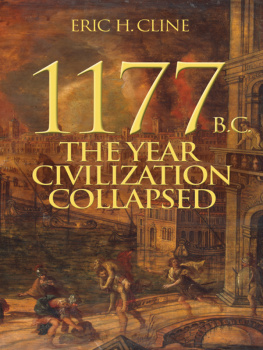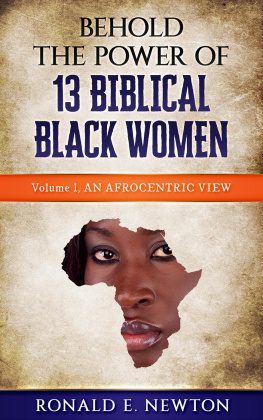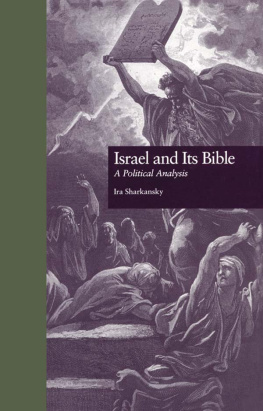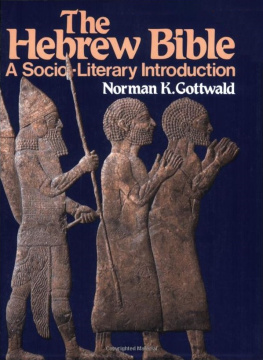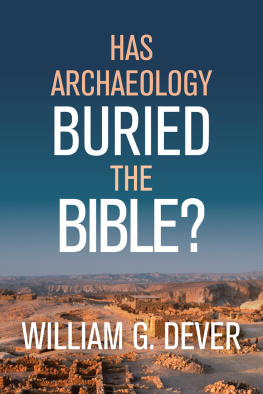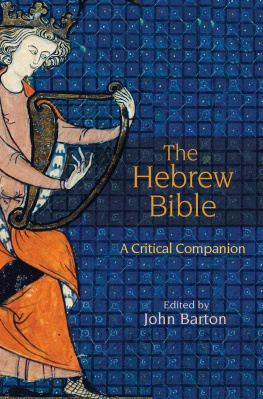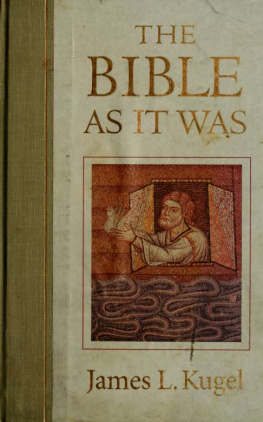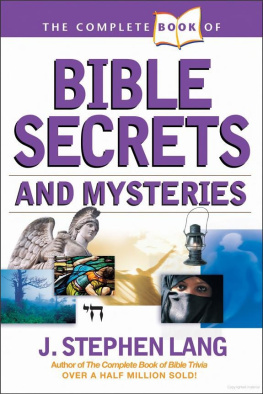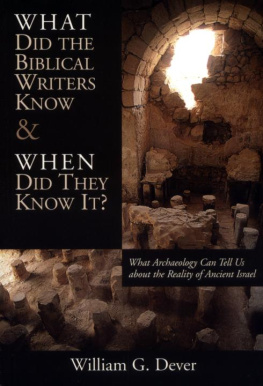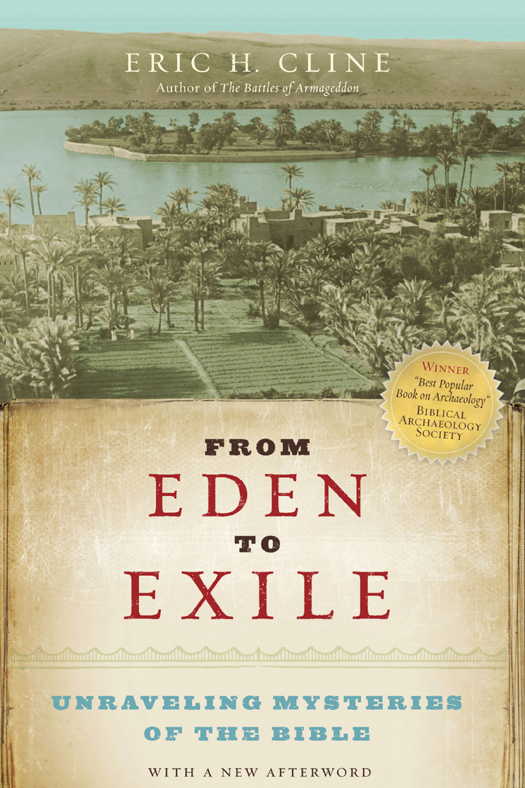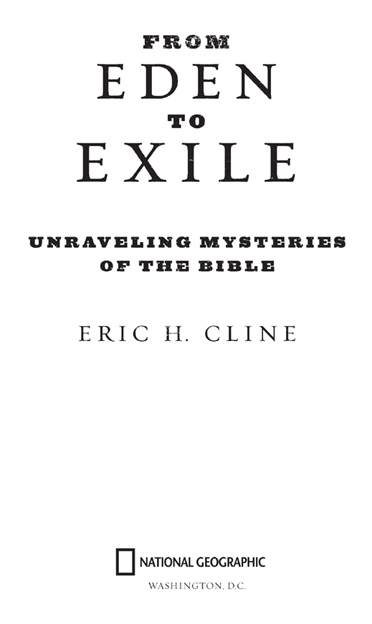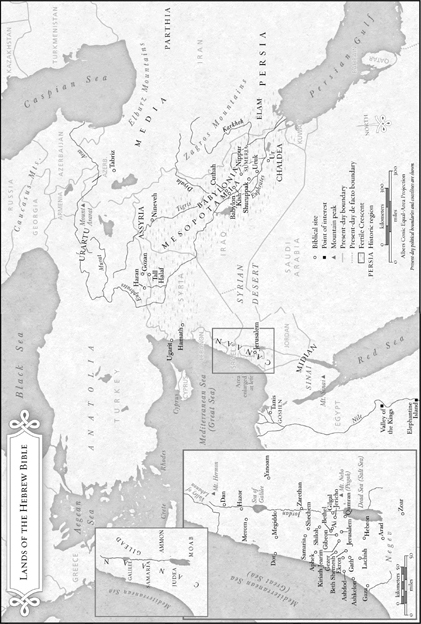Copyright 2007 Eric H. Cline. Afterword copyright 2012 Eric H. Cline. All rights reserved. Reproduction of the whole or any part of the contents without permission is prohibited.
The Scripture quotations contained herein are from the New Revised Standard Version Bible, copyright 1989 by the Division of Christian Education of the National Council of Churches of Christ in the U.S.A., and are used by permission. In addition, some material in this book previously appeared in oral and/or written form by the present author and appears here with the permission of Modern Scholar/Recorded Books (www.modernscholar.com).
The Library of Congress has catalogued the hardcover edition as follows:
Cline, Eric H.
From Eden to exile : unraveling mysteries of the Bible / by Eric H. Cline. 1st ed.
p. cm.
eISBN: 978-1-4262-1224-6
1. Bible. O.T.Evidences, authority, etc. 2. Bible. O.T.History of Biblical events. 3. Bible. O.T.Antiquities. 4. Bible. O.T.Criticism, interpretation, etc. 5. JudaismHistoryTo 70 A.D. 6. JewsHistoryTo 70 A.D. I. Title.
BS1180.C64 2006
221.67dc22
2007003122

Founded in 1888, the National Geographic Society is one of the largest nonprofit scientific and educational organizations in the world. It reaches more than 285 million people worldwide each month through its official journal, N ATIONAL G EOGRAPHIC , and its four other magazines; the National Geographic Channel; television documentaries; radio programs; films; books; videos and DVDs; maps; and interactive media. National Geographic has funded more than 8,000 scientific research projects and supports an education program combating geographic illiteracy.
For more information, please call
1-800-NGS LINE (647-5463)
or write to the following address:
National Geographic Society
1145 17th Street N.W.
Washington, D.C. 20036-4688 U.S.A.
Visit us online at www.nationalgeographic.com/books
Interior Design: Cameron Zotter
v3.1
CONTENTS
INTRODUCTION
The greatest challenge for anyone trying to solve a Biblical mystery is that the Bible interweaves the historical and the theological, the mystical and the verifiableoften in one sentence.
Molly Dewsnap Meinhardt, Biblical Archaeology Society
T here are many mysteries in the Bible. Some cannot be explained and must remain as mysteries or even miraclesat least for now, if not forever. Other mysteries can be discussed rationally within a historical and archaeological framework. A number of these, including the Garden of Eden, Noahs ark, Sodom and Gomorrah, Moses and the Exodus, Joshua and the Battle of Jericho, the Ark of the Covenant, and the Ten Lost Tribes, are of great interest to many people. It is on these seven mysteries that we will concentrate here.
While doing the research for this book, I became amazed and, frankly, appalled by the amount of pseudoscientific nonsense that has been published on these topics, especially on the Internet but also in book form. The vast majority of this work has not been produced by professional scholars but rather by amateur enthusiasts, some of whom we will meet in the following chapters. These enthusiastsmost of whom are self-trained and self-employed, and some of whom publish only, or primarily, on the Internetall work outside of academia. As such, they are not held to the same standards of rigor, peer review, and scrutiny as professional scholars employed by colleges, universities, and other institutions of higher learning. Indeed, the work of such enthusiasts frequently meets the criteria of junk science, especially when it, as Ron W. Pritchett has explained, advocates a cause, pays little attention to the investigative process, ignores contrary evidence, and advertises a high moral purpose.
Quite frequently, the public embraces such enthusiasts, for they are entertaining and passionate, for the most part. And, unfortunately, when it comes right down to it, it seems that a good but erroneous story trumps good but boring data every time: The enthusiast might be completely wrong, but he or she is frequently a charismatic storyteller who never lets the facts get in the way of a good story. As a result, such stories frequently reach a larger audience than the more detailed and often dry work of the archaeologists, ancient historians, and biblical scholars. On television shows or in media articles devoted to these stories, real scholars are often reduced to the role of mere commentators and nattering nabobs of negativism, to use the words of former Vice President Spiro Agnew and William Safire in a new context. Frequently, these experts come off as spoilsportsan effete corps of impudent snobsrefuting the exciting nonsense being spewed by those who have no formal training in history or archaeology and who are, as they say, taking on the establishment.
That is not to say that the work of such enthusiasts is always without merit or completely flawed. Some of them may have good evidence or logical clues that they are following, but then come to faulty or erroneous conclusions. Sometimes they are simply guilty of wishful thinking or of reading too much into the evidence. Other times they are guilty of setting off on their investigations with an a priori set of assumptions, such as the infallibility of the Bible, which does not inspire confidence in the impartiality of their investigations. They frequently do not seem to know, or care, that there are larger debates within the fields of biblical studies, ancient history, and archaeology that will (or should) affect their studies, ranging from biblical criticism and source theory to the validity and accuracy of radiocarbon dating.
The materials written and published by some scholars on these topics can also be problematic, especially the most fervent of the evangelical biblical maximalists, who see the Hebrew Bible as infallible, and the biblical minimalists, who see the Hebrew Bible as a late (that is, Persian or Hellenistic) fabrication. Some biblical maximalistsparticularly those working outside of mainstream academiaseem to be closer to the enthusiasts in setting out with their own a priori set of assumptions, which are often stated outright in the mission or message statements on their Web sites. Others dilute their good and careful analysis of archaeological material and ancient literary sources with uncritical thinking or blatant proselytizing. In addition, both the maximalist and minimalist camps harbor individuals who abuse and occasionally distort the information.
Thus, one of the reasons I have written this book is to sound both a word of warning and a call to arms, because I believe that the general public deservesand wantsbetter. It is high time that professional archaeologists, ancient historians, and mainstream biblical scholars take back their fields from the amateur enthusiasts, pseudoscientists, uninformed documentary filmmakers, and overzealous biblical maximalists and minimalists who have had, for the most part, free rein to do what they wish, without any regard to scientific method or an unbiased investigation for the truth. In return, though, we as academics owe it to the general public to deal with these mysteries in a serious way and to publish our findings. Even if our investigations come up empty, it is frequently the journeyincluding the benchmarks established and information imparted along the waythat is most valuable and sometimes even more interesting than the end result.







